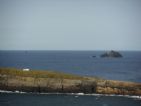
Introduction I
Comparisson reports are under license of:

Lo que dice el Arxiduc:
“All of the islands contain the same geognostic elements. Specifically, they are all volcanic, similar to tuff in terms of the shape of their strata, or with slightly sloping layers, crowned by a thick deposit of blackish cellular basalt, which seems to have originated from a current of lava that once filled the crater. This crater—which, during the eruption, had been a complete cone—represents just two thirds of the circumference that was destroyed by the action of the sea on its most exposed face, the north-northeast face.”
Urios, G., Nachtwey, J., Translation, Columbretes, 1895, Castellón City Council, 1990.
Datos proyecto Nixe III:
ColumbretesIslands are at least 300,000years old, while the last eruptions were registered approximately 130,000 years ago.We should remember, for example, that the oldest area on the Aeolian (or Lipari) Islands is Strombolicchio, approximately 200,000 years old.
ColumbreteGrande (or Illa Grossa) was created, ineffect, when the crater collapsed on the north-east side where the erosion from the sea has been felt the most.

For those interested in exploring this topic further, we recommend the following book chapter:
Alonso Matilla, L.A., “Geologiaestructural delarchipiélagode las Columbretes”,
in Alonso Matilla, L.A., Carretero, J.L., García Carrascosa, A.M.,Islas Columbretes. Contribuciónel estudio de su medionatural, Generalitat Valenciana, 1991 (1987).
















